Carb Evolution
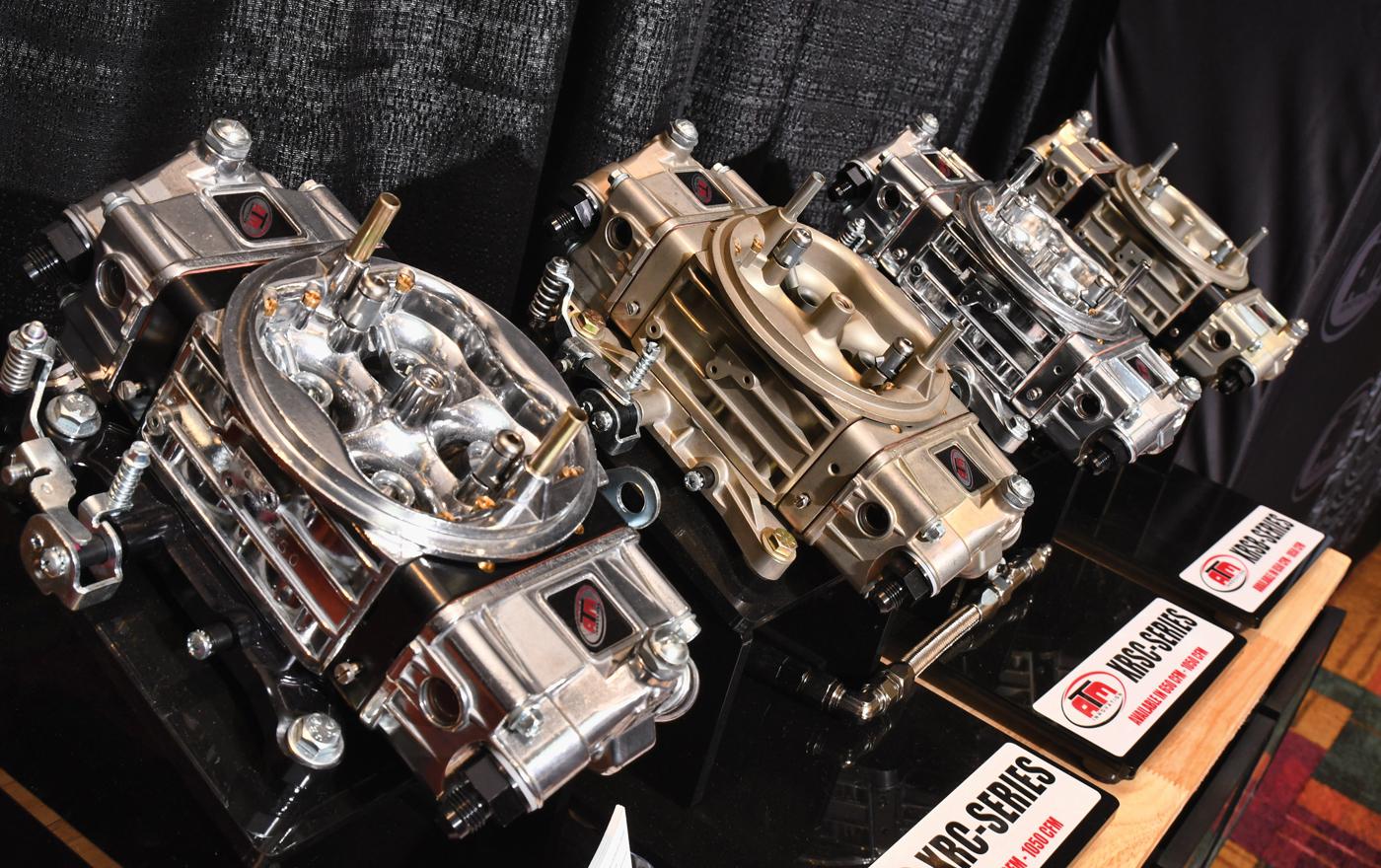
Manufacturers keep up with race engine changes through constant R&D and on-track testing. Here’s a look at what’s new, plus tips on whether to rebuild or replace a worn component.
For some racers, electronic fuel injection represents the cutting edge of engine induction technology. That case certainly can be made, given the large number of tuning parameters that are precisely manipulated by the latest computer software. Yet for others, that complexity doesn’t appeal. Instead, they compete—and win—using some version of a device that has been called a “controlled fuel leak.”
“Most of our customers have tried fuel injection, but they don’t want to tune all the time, they just want to race,” said Trevor Wiggins of GET’M Performance, Alvaton, Kentucky. “A carburetor just works, and it’s really easy.”
“A carburetor can make more torque, more horsepower, and use less fuel than EFI,” said Dave Braswell of Braswell Carburetion, Tucson, Arizona. That remains true, he said, even as drag racing V8s continue to grow in size and output, and can spin at 10,000 to 11,000 rpm.
Meeting the needs of these evolving powerplants requires never-ending R&D on the part of carburetor manufacturers. “We’re constantly changing and trying different things,” Braswell said. “It’s the only way to stay ahead of the game.”
What follows is the latest information on carburetor development from Braswell, Wiggins and other leading manufacturers.
‘The Sky’s the Limit’
While AED Performance in Richmond, Virginia, “can build a carburetor for just about anything,” said Jeff Harris, “we focused a lot of our R&D this year on high-end drag race applications. We were a class sponsor of PDRA’s Extreme Pro Stock class, working with a couple of those teams and a couple of the guys in the Pro Outlaw 632 class.” One of the company’s owners, Jay Brockwell, traveled with the Pro Stock teams “and did most of the R&D in person at the track.”
The result is a new billet bowl that can better “control the fuel in the bowl before the carb can meter it,” Harris explained. “It makes the fuel that the metering block sees and the fuel that you’re trying to meter more consistent. It keeps it from aerating, keeps it from sloshing from one side to another.”
Working at the track was a crucial part of the development process. “G-forces change things. Running something on the dyno versus getting something to run on the race track are two completely different things in the carburetor world. On the dyno it sits still. But with these Pro Outlaw 632s and Extreme Pro Stock guys, you’re talking some really quick 60-foot times. You need to control the fuel as the car leaves, to make the launch more consistent. So we’re working not only on control in the bowl, but also the quality of the fuel charge to the combustion chamber itself. We are constantly winnowing in on it to make the best piece we can.”
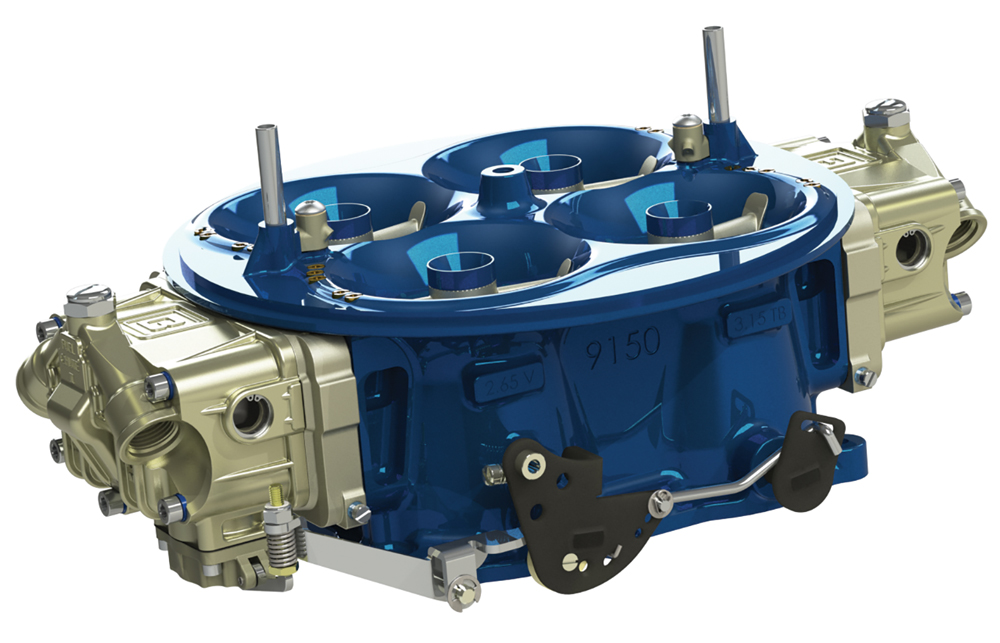
Another factor that proved invaluable to development at the drag strip was data acquisition, Harris added. “We’re able to take that data at the track and make changes accordingly. It makes a big difference in making sure the engine is optimally tuned for each customer. In some cases, without that capability, we could be leaving anywhere from 10% to maybe 20%, on the high end, of power on the table. Even if it’s 10%, 80 horses out of 800 is a big deal. And again, something that may not show up on the dyno would definitely show up under load and at speed on the race track.”
Real-world R&D goes hand-in-hand with the company’s CNC capabilities to continually develop its carburetor components. Harris said, “We are constantly evolving our metering blocks and producing different sizes of billet bodies. Those are the kinds of things that the CNC world allows us to do. The sky’s the limit. We can machine things better and better to fit each application. Each carburetor is as custom as we can make it.”
‘Refined Everything’
“We’ve refined everything we’ve been making,” Braswell said about his company’s R&D efforts. On the circle track side, “We recalibrated for the 602 and 604 crate motor classes. We make five carburetors for each of those engines, depending on the fuel they’re using: pump gas, 110, CHP, E85, ethanol and methanol. We change the venturi diameter and throttle-bore diameter for the different fuels. Also, the metering plates have a different calibration to optimize their performance with those fuels.”
Refinements have also come to the carburetors for Late Model open engines. “Late Model motor development in the last 10 years has happened so rapidly, it’s a moving target. What worked last year doesn’t work as well this year, so we have to come up with a better product to improve driveability, torque, and horsepower as cylinder heads and displacement change.”
For drag racers, Braswell has updated its carburetors “mostly with metering changes.” Changing metering plates on the carburetors for some Competition Eliminator engines “was worth two- to three-hundredths in the 60-foot, which is significant. We’re incorporating those changes across the line into different classes.”
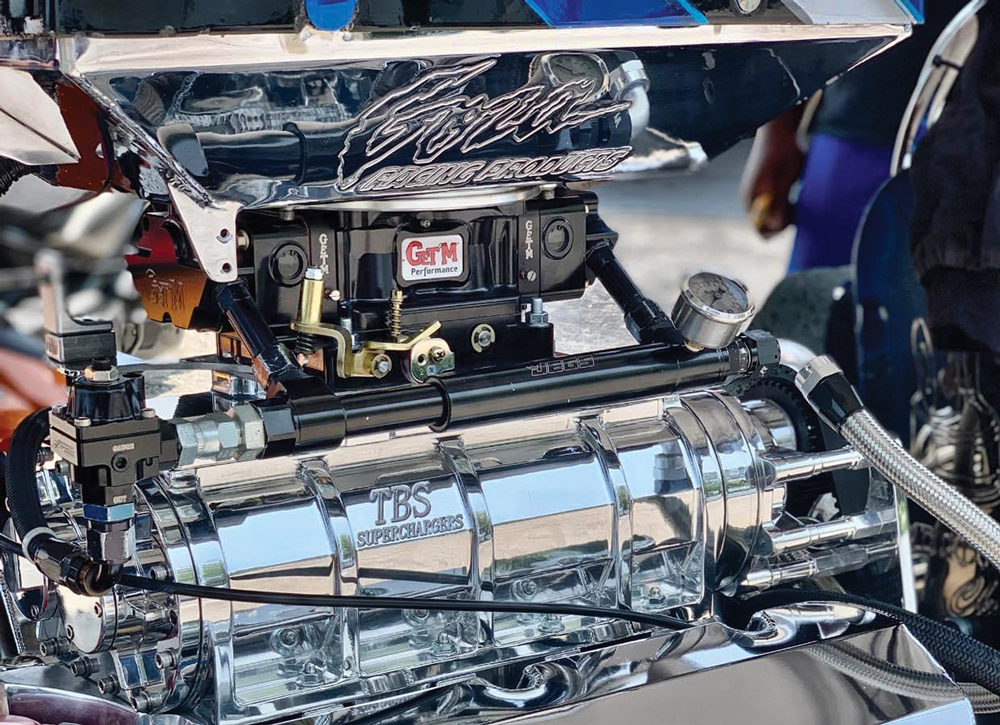
Braswell is also redoing the tooling for the B-7520 two-barrel carburetors “to go to a 2.700-inch butterfly,” he said. These are used in Mountain Motor Pro Stock, Top Sportsman, and other big-inch classes. “Big motors used to be 600 or 800 inches. Now a big motor is more than 900 inches, so we’re trying to keep up with the ever-moving target of the application.”
Engines are not only getting bigger, but they’re also spinning faster, he said. “Back in the 1990s, a high-rpm motor was turning 7,500 rpm. Now, a drag race motor routinely turns over 11,000 rpm.” At those speeds, “airflow through the carburetor actually drops off because the motor’s volumetric efficiency decreases. But pulsations from the intake cycle also tend to make the carburetor go rich at higher rpm—the rebound wave also meters fuel in the carburetor. We had to keep changing our metering systems to keep up. Where most modular carburetors produced today have just a single air bleed on the high-speed circuit, we’re using up to three high-speed bleeds. This enables us to better tailor the fuel curve at the higher rpm these engines are running.”
‘We Have to Keep Making Them Bigger’
While “everyone knows us for our Twin Blade,” Wiggins said, GET’M Performance released three four-barrel carburetors last year. One was a 1,050-cfm throttle-stop-style carburetor, the other two came in at 1,250 to 1,300 cfm and 1,750 cfm.
“The four-barrel is an easy transition for people to move to our stuff, especially racers who already have a four-barrel,” he explained. “The four-barrel is widely accepted in the throttle-stop world and very well accepted in larger engine markets. A 632 that made 1,100 horsepower used to be a big motor. Now there are 632s that make upwards of 1,400 horsepower. We have to keep making them bigger to get in the arena of our customers who are making 1,350 to 1,400 horsepower.”
The 1,750-cfm four-barrel “is more our future world,” Wiggins said. “To stay ahead of the curve, we’ve even been testing a 1,900-plus-cfm carburetor.” On the Twin Blade side of his business, Wiggins has a carburetor in development with a capacity of “around 2,100 cfm,” and a Dominator-style Twin Blade that is “probably a year away” from release.
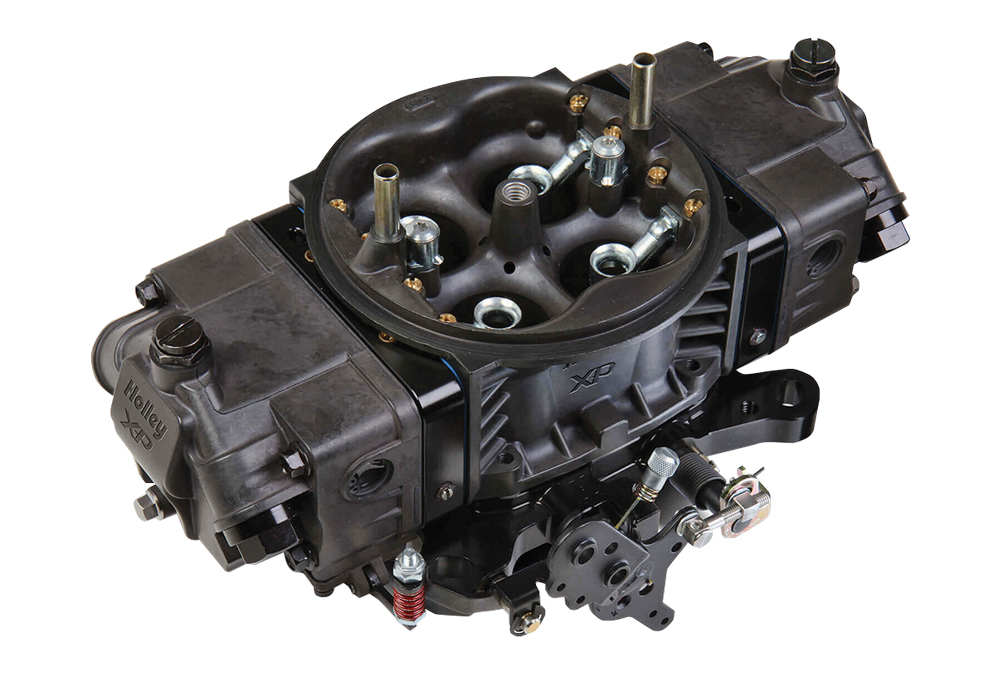
Carburetor development isn’t just about big cfm numbers, Wiggins said. “We’re trying to get a venturi-to-throttle-bore ratio. That’s how we’re able to achieve more and more cfm. The bigger bore doesn’t necessarily mean the largest venturi. You’re trying to get the ratio that you know is very consistent and works very well through the low, mid, and high range of engine air demand. I can build any size venturi. I can build a straight venturi. But if you can’t get it to idle, or transition to wide open, it doesn’t matter how big it is.”
Another trend Wiggins is paying attention to is the use of “baby blowers”—250-cubic-inch Roots-style superchargers—on bracket race engines.
“A lot of people are looking for more horsepower without spending a lot of money,” he explained. “They’re putting these baby blowers on their bracket motors with a single carburetor on top. That makes us build a more efficient carburetor and a more efficient metering block to feed enough fuel through a baby blower.” The setup, he said, “has been a large seller for us.”
Beyond carburetors, GET’M Performance is branching out into ancillary components: fuel pressure gauges, fuel logs, and bypass regulators, among others. “If you call me and say the engine’s not running right, I always ask what the fuel pressure is,” Wiggins said. “A lot of people don’t know, or they’ll have to pull the Racepak up. So I decided I’m going to start supplying gauges.”
‘Carbs on a Diet’
Laura Shehan of Holley Performance in Bowling Green, Kentucky, said the company last updated its racing carburetors several years ago with the introduction of the XP and Gen 3 Dominators and the associated calibrations for E85, methanol, and dual-quad setups.
“When we embarked on the 4150 XP, we realized we needed to refresh the entire lineup from both an aesthetic and performance perspective, not to mention put the carbs on a diet by making the change from zinc to aluminum. We considered the typical upgrades that the modifiers were doing and implemented them in a well-tuned, out-of-the-box carburetor.”
“Those older carburetors were kind of behind the times,” agreed Holley’s Tyson Rinehart. “We decided to give them a new look and change some of the things the modifiers were changing on the older carbs. That way they could have everything at their fingertips.”
The switch from zinc to aluminum had benefits beyond shedding weight, Rinehart explained. “There’s also heat soak. Zinc held in a lot of heat, while the aluminum will dissipate it. There’s not as much expansion, boiling the fuel and stuff like that with the aluminum series.”
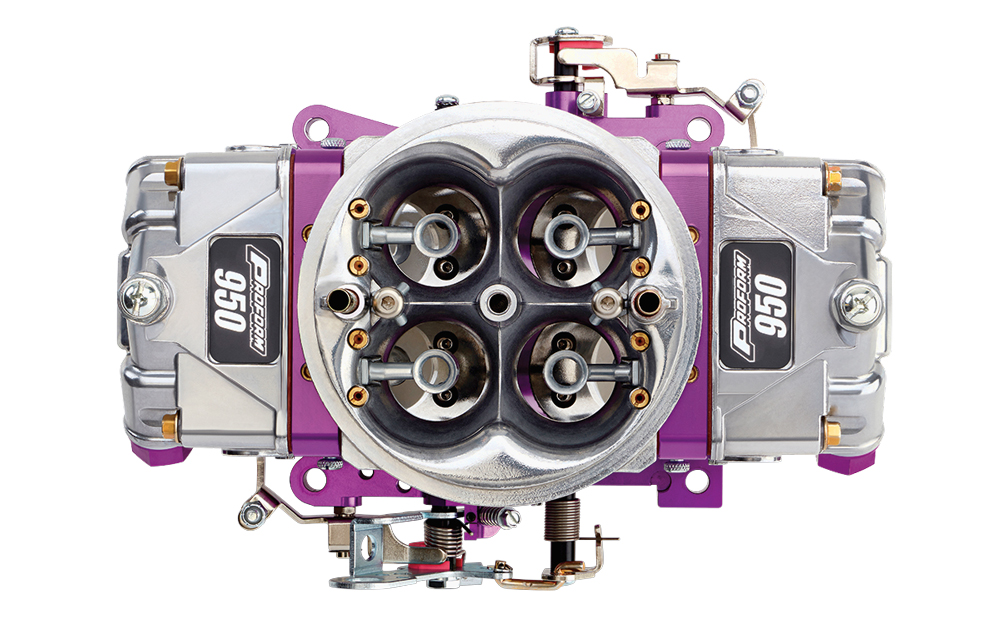
“On the XP and Gen 3 lineup, we implemented billet metering blocks and throttle bodies,” Shehan said. “Each of the metering blocks went through exhaustive testing and was designed specifically taking into account carburetor size, fuel, and application. Regarding the fuel bowls, we added 20% fuel capacity, anti-slosh baffling, and a drain plug feature. The main bodies of the 4150 XP and Gen 3 Dominator have the idle bypass system that works to allow the idle air to be set without losing the functionality of the transfer slot for off-idle fuel.”
Holley’s 2300 XP two-barrel also went through an update. “We eliminated the choke tower to transition the carburetor into a full-out race carburetor,” Shehan said. “Like the 4150 XP and Gen 3 Dominator, the 2300 XP also has a billet metering block and throttle body, as well as a high capacity fuel bowl. We integrated an anti-siphon system into the accelerator pump channel in the main body to reduce the draw of fuel from the accelerator pump.”
As a volume carburetor manufacturer, Holley faces a unique challenge, Shehan said. It needs to “provide a calibration that will perform upon installation, provided the carb is appropriately sized, and yet have the flexibility and range to be tuned specifically for that application by the end user,” she added.
‘18 New Carburetor Part Numbers’
PROFORM Parts of Warren, Michigan, has made what it calls “major design enhancements” to its Race Series carburetors. “Our tooling needed to be readjusted, so we had the opportunity to do a redesign and add features to our existing line,” said Ryan Salata. The company also added three new lines to the Race Series inventory, “18 new carburetor part numbers,” Salata said, for supercharger, circle track and alcohol, and E85 applications.
Improvements have been made throughout the carburetors. Among the most significant, according to PROFORM’s Dennis Grzebyk, are new lower fuel ramps in the bowls. “The fuel chute is a big deal. It stops the aeration of fuel into the fuel bowls from the needles. It creates a downslope, so the fuel goes down and under rather than splashing directly down.” Another facet of the new bowl design is increased internal baffling to control fuel slosh
during high-G-force situations like rapid acceleration and cornering.
The aluminum main bodies have been redesigned, with a contoured leading edge to the venturis to smooth the air coming into the main body. “The way the main body is knifed, you see nice cuts on the casting,” Grzebyk said. “The air bleeds are recessed a little further back into the body for airflow into the venturi.” The main bodies also have new, double-step annular boosters that improve fuel atomization and throttle response.
The billet throttle base plates are now built with slabbed throttle shafts with low-profile screws, which improves combustion efficiency by decreasing the air resistance into the venturis. PROFORM has also engineered more surface area in the base plates, which provides more contact between the main body and blocks to make that assembly stronger and more rigid. And within the metering blocks are eight pre-drilled emulsion channels that are tunable to allow precise control of the air/fuel mix.
In sum, the changes result in “improved performance, better fuel retention, and reduced slog,” Salata said. “We expanded our carburetor’s capabilities to fine tune and drill down.”
Rebuild or Replace? Expert Tips on Carburetor Care
When is it time to rebuild a carburetor? “Usually power or driveability will start to drop off, or you’ll develop a flat spot when you get on the throttle,” said Dave Braswell of Braswell Carburetion, Tucson, Arizona.
“If it doesn’t idle right, or you hear it miss from time to time, that’s an opportunity for a rebuild,” offered Trevor Wiggins of GET’M Performance, Alvaton, Kentucky. “For drag racing, if you go and deck the motor on a two-step and it doesn’t deck clean, something’s not right.”
“If the engine is consuming a lot of fuel, or it’s leaking a lot of fuel, or it just doesn’t have the performance peak that it used to, most likely that’s time to rebuild,” said Tyson Rinehart of Holley Performance, Bowling Green, Kentucky.
“You’ll see your performance drop or fall off,” added Dennis Grzebyk of PROFORM Parts, Warren, Michigan. “Times or miles per hour will change for the negative. That usually means something’s clogged, there’s sediment in an orifice, or possibly a bad power valve.”
Jeff Harris of AED Performance in Richmond, Virginia, brought up another kind of clog: “Fuel cell foam is one of those things that people never think of. It deteriorates over time and ends up in the carburetor.”
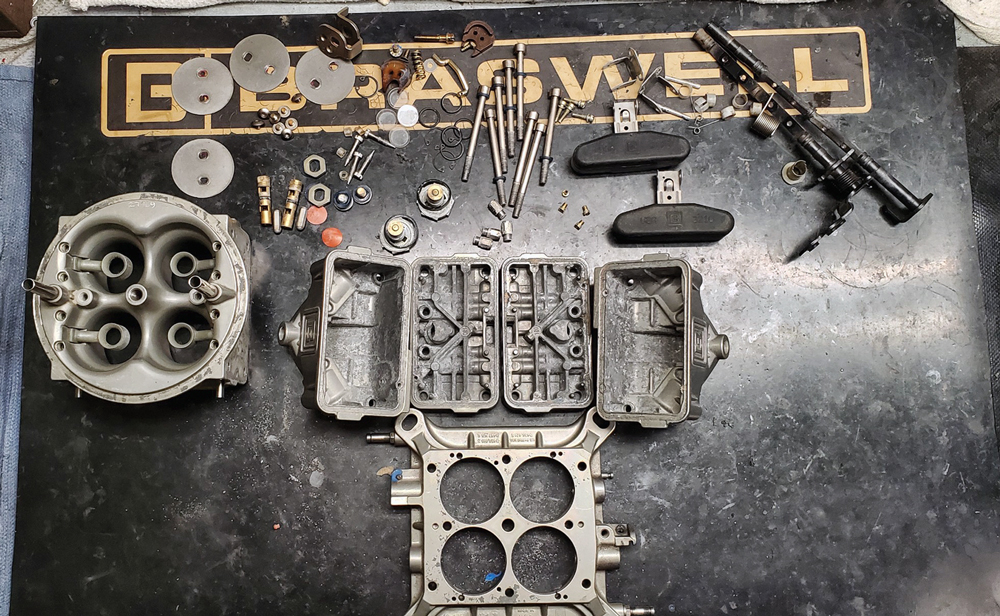
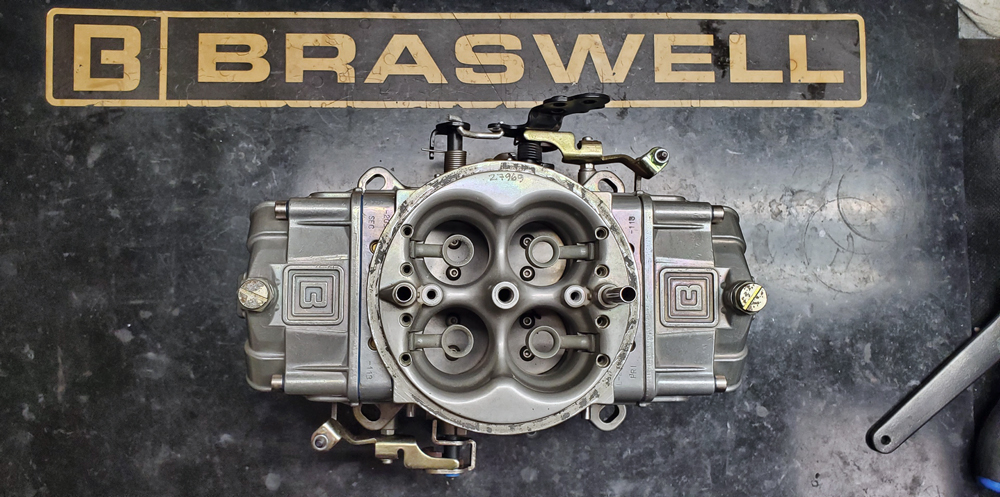
Simple neglect also can be the root cause of carburetor problems. “I’ve had customers who rebuilt their engines several times and didn’t touch the carburetors,” Braswell said. “Then things aren’t working as well, and they wonder what’s going on.”
One easy thing racers can do to improve a carburetor’s longevity is to drain the float bowls when the car is on the trailer, Braswell said. Otherwise, “the fuel in the float bowls bangs on the needles and seats. It wears parts out just going down the road.”
“It’s never a bad idea to do maintenance through the year,” Harris said. “At the end of the year, pop the carburetor off, clean it out really well, freshen it up with a new set of gaskets, and have it ready to go for next season. Two hours on a Saturday with a can of carb cleaner and some gaskets may save you some headaches.”
Certain race fuel types can also cause trouble. “Q16 will actually eat the metal as it goes through,” said Rinehart. “It will take anodizing off and make passages bigger over time. That will take a toll. Q16 is...an effective fuel, but it’s not a friendly fuel.”
“Alcohol is very corrosive compared to gasoline,” Wiggins said. “If alcohol sits in the carburetor, it will start working on the floats, making them heavier. Alcohol will work on where the anodizing isn’t as thick, and it will start to corrode. Then the carburetor won’t respond accurately. It won’t idle accurately. The motor won’t do a burnout accurately, or it won’t run down the track accurately.”
To keep that from happening, “every two to three years, we tell our customers to ship our carburetor back and we’ll rebuild it for free,” Wiggins said. “It’s more important to me that my carburetors run good than the time it’s going to take me to tech it when it starts to act stupid. We want our carburetors to run good, and we want our people to win.”
Under most circumstances, rebuilding, rather than replacing, can cure a carburetor’s ills. “Usually you can rebuild a carburetor to the end of the earth,” Grzebyk said. “With billet stuff, you’ll probably have that carburetor forever unless you outgrow it. But if you’re working with an outdated carburetor, with old technology compared to what’s available today, that’s a good time to replace your old one.”
Damage can also get to a point where a carburetor has to be replaced rather than rebuilt. “This newer gas with a lot of ethanol in it will eat on some of the metal almost like electrolysis,” said Rinehart. “It will pit the metal. If you get excessive pitting, that will turn into holes. That’s when it has to be replaced. It’s not going to get any better at that point.”
Damage isn’t the only reason to replace a carburetor. Years of use can also just wear one out, said Wiggins. Beyond excessive wear, the most common reason to replace a carburetor “is if you change the situation,” he said. “If you change the motor size, change cars, change fuel, it might be easier to replace it. If you’re going from gas to alcohol, for example, and your cast carburetor has a cast bowl that is not coated, alcohol will eat up the castings. Alcohol or E85 will not eat up billet or anodized products in the same way it eats away at cast aluminum.”
Because all GET’M Performance carburetors come with anodized billet fuel bowls, making the change from one fuel type to another may not require a complete carburetor replacement. “Often we can still utilize the same main body and fuel bowls in changing our customer’s carburetors to a different fuel setup or application,” Wiggins added.
“People switch back and forth,” Braswell said. “They’ll race at a different track, or the rules change. They’ll want to take their alcohol carburetor and switch it to gas or vice versa. Usually we’ll swap main bodies and metering system, or we’ll just build them another carburetor, so no matter where they race, they’ll have a carburetor.”
“If you start with a 300-horse motor or a 500-horse motor, and you want something that makes 800 horses, you’re better off to start over in most cases,” Harris said. “In the race car world, carburetors are not terribly expensive, relatively speaking. Something that’s custom or one-off for each engine, even at the high end, is in the $2,000 range. Two thousand bucks in a race car is still a relatively low number, especially for something that’s one-off per customer, per engine, per fuel and per application.” —Drew Hardin
SOURCES
–
AED Performance
aedperformance.com
Braswell Carburetion
braswell.com
GET’M Performance
getmgarage.com
Holley Performance
holley.com
PROFORM Parts
proformparts.com
 MEMBERSHIP LOGIN
MEMBERSHIP LOGIN JOIN PRI
JOIN PRI


